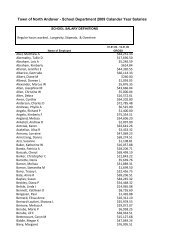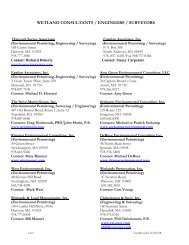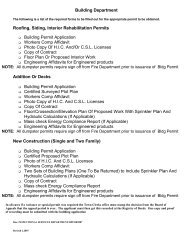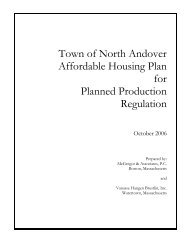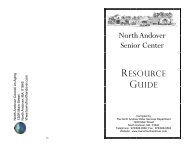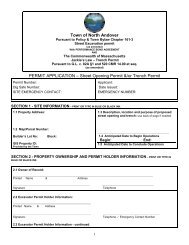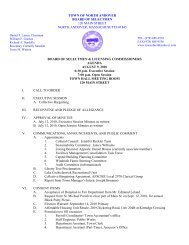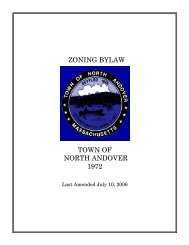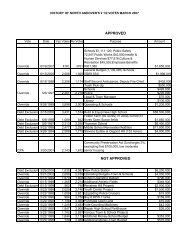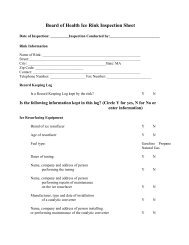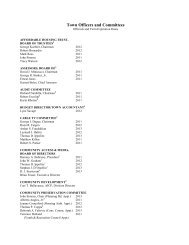Open Space and Recreation Plan - Town of North Andover
Open Space and Recreation Plan - Town of North Andover
Open Space and Recreation Plan - Town of North Andover
You also want an ePaper? Increase the reach of your titles
YUMPU automatically turns print PDFs into web optimized ePapers that Google loves.
T O W N O F N O R T H A N D O V E R<br />
O P E N S P A C E A N D R E C R E A T I O N P L A N 2 0 0 6<br />
2 0 1 0 U P D A T E<br />
waste produced by the regional wastewater treatment plant. However this incinerator was closed in 1988 due<br />
to the release <strong>of</strong> high levels <strong>of</strong> air pollutants. In 2002, the GLSD retr<strong>of</strong>itted the incinerator with new<br />
technology that produces a product that pelletizes the sludge to usable fertilizer called biosolid h<strong>and</strong>ling. A<br />
capped ash l<strong>and</strong>fill is currently on site <strong>and</strong> has been tested within required environmental parameters. Due to<br />
the possible health affects <strong>of</strong> incineration, sludge can no long be burned.<br />
Flooding<br />
The November 2008 Merrimack Valley Region Natural Hazards Pr-Disaster Mitigation <strong>Plan</strong> identifies flooding<br />
as a major concern in <strong>North</strong> <strong>Andover</strong>. The report cites 4.8 square miles <strong>of</strong> <strong>Town</strong> <strong>of</strong> <strong>North</strong> <strong>Andover</strong> l<strong>and</strong> in the<br />
100-year floodplain <strong>and</strong> another 0.6 sq. mi. within the 500-year floodplain. These two flood zones constitute<br />
almost twenty percent (20%) <strong>of</strong> the total area <strong>of</strong> the community. Road closures during flood events are typical<br />
including Great Pond Road <strong>and</strong> Massachusetts Avenue. Several neighborhoods near the Shawsheen <strong>and</strong><br />
Merrimack Rivers have also been evacuated during recent extreme flood events.<br />
Development Impacts<br />
There are both short-term (during construction) <strong>and</strong> long-term (after construction) environmental impacts due<br />
to l<strong>and</strong> development. These impacts are particularly negative with regard to wetl<strong>and</strong>s <strong>and</strong> water bodies,<br />
especially when these wetl<strong>and</strong>s <strong>and</strong> water bodies may be tributaries to a public water supply such as Lake<br />
Cochichewick. The Lake Cochichewick Watershed <strong>Plan</strong> (IEP, 1987) identified erosion in areas <strong>of</strong> new<br />
construction as one <strong>of</strong> the "primary sources <strong>of</strong> elevated suspended solids, nutrient <strong>and</strong> bacteria concentrations".<br />
Erosion during the construction process <strong>and</strong> siltation <strong>of</strong> water bodies can have a variety <strong>of</strong> impacts, depending<br />
on the soil characteristics. "There are three general soil types - fine muck, clay, <strong>and</strong> s<strong>and</strong> - all <strong>of</strong> which must be<br />
kept from eroding into the water. Fine muck, if introduced into a stream, will cloud the water <strong>and</strong> create what<br />
is known as biological oxygen dem<strong>and</strong>. This depletes the waters <strong>of</strong> dissolved oxygen (DO), causing a reduction<br />
in fish <strong>and</strong> other aquatic organisms that depend on the DO for respiration. Clays will create a milky cloud that<br />
can clog the gills <strong>of</strong> fish living in the streams' waters. Fine muck <strong>and</strong> clays impact waters on a short-term basis.<br />
S<strong>and</strong>, however, may be the most harmful <strong>of</strong> all eroding soils because <strong>of</strong> its long-term implications. The s<strong>and</strong><br />
fills in gravel beds, which is used by fish as spawning beds." (Maynard, 1992)<br />
In addition, future development could increase challenges faced due to flooding. According to MVPC analysis,<br />
169 acres <strong>of</strong> “potentially developable” l<strong>and</strong> under current zoning is within the 100-year <strong>and</strong> 500-year flood<br />
zones. According to the Natural Hazards Pre-Disaster Mitigation <strong>Plan</strong> (2008), “development <strong>of</strong> this open space<br />
would increase the area’s impervious surface cover <strong>and</strong> stormwater run<strong>of</strong>f, thereby exacerbating the existing<br />
flooding problems.”<br />
38




